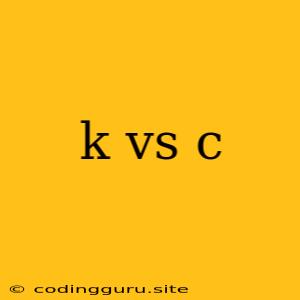K vs C: A Comprehensive Comparison
Choosing the right programming language for your project can be a daunting task. Two popular choices, often pitted against each other, are K and C. Both languages have their strengths and weaknesses, making it crucial to understand their differences to make an informed decision.
K and C cater to different programming paradigms and have distinct applications. Let's delve into their characteristics and see which one emerges as the better choice for your specific needs.
What is K?
K is a high-level, array-oriented programming language developed by Arthur Whitney. It's known for its concise syntax and powerful data manipulation capabilities. K's strength lies in its ability to process and analyze large datasets efficiently, making it a favorite for quantitative finance, data science, and machine learning.
What is C?
C is a structured, procedural programming language developed by Dennis Ritchie. It's known for its low-level access to hardware, making it a popular choice for system programming, embedded systems, and operating systems. C offers a high degree of control over memory management and hardware interactions.
Key Differences: K vs C
Let's explore the fundamental differences between these two languages:
1. Programming Paradigms:
- K is an array-oriented language, emphasizing data manipulation and vectorized operations. It's declarative, allowing you to specify what you want to achieve rather than how to achieve it.
- C is a procedural language, where code execution follows a sequential flow of instructions. It's imperative, requiring you to explicitly define each step in the program's execution.
2. Data Structures:
- K excels in manipulating arrays and matrices. It provides built-in functions for advanced data manipulation, making it efficient for complex computations.
- C utilizes basic data structures like arrays, structures, and pointers. Its focus on memory management and low-level access gives developers fine-grained control over data representation.
3. Performance:
- K is known for its high performance due to its optimized vectorized operations. It leverages the underlying hardware effectively for efficient data processing.
- C is a compiled language, offering fast execution speeds. Its ability to interact directly with hardware resources minimizes overhead and maximizes performance.
4. Learning Curve:
- K's concise syntax and functional approach can be challenging for beginners. It requires understanding its unique data manipulation techniques and array-oriented concepts.
- C has a relatively gentler learning curve, especially for programmers familiar with imperative programming. Its syntax is more intuitive and easier to grasp.
5. Applications:
- K is ideal for applications requiring data analysis, financial modeling, and quantitative algorithms. Its ability to handle large datasets efficiently makes it a strong choice for machine learning and high-frequency trading.
- C shines in system programming, embedded systems development, and operating systems creation. Its low-level access and control over hardware resources make it well-suited for performance-critical applications.
When to Choose K?
K is a good choice for:
- Data-intensive applications: Its array-oriented nature and optimized data manipulation capabilities make it ideal for processing and analyzing vast amounts of data.
- Financial modeling and quantitative finance: Its powerful mathematical and statistical functions facilitate complex financial calculations and analysis.
- Machine learning and data science: Its vectorized operations and efficient data handling capabilities accelerate machine learning algorithms and data analysis tasks.
- High-frequency trading: Its speed and efficiency are crucial for executing trades in real-time.
When to Choose C?
C is a suitable choice for:
- System programming: Its low-level access and control over hardware resources make it well-suited for building operating systems, device drivers, and system utilities.
- Embedded systems development: Its ability to optimize resource utilization and interact directly with hardware components makes it suitable for developing embedded systems for devices with limited resources.
- Performance-critical applications: Its compiled nature and direct access to hardware ensure high execution speeds and minimal overhead.
- Applications requiring precise control: Its ability to manipulate memory and hardware directly gives developers fine-grained control over resource allocation and program execution.
Conclusion
K and C are powerful programming languages with distinct strengths and weaknesses. Choosing the right one depends on the specific requirements of your project.
K excels in data-intensive applications, quantitative finance, and machine learning, while C shines in system programming, embedded systems development, and performance-critical tasks. Understanding their key differences and applications will help you make an informed decision for your next programming project.
